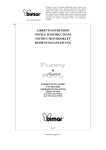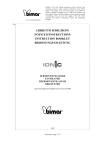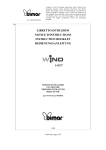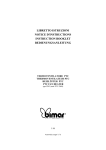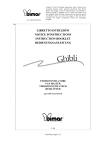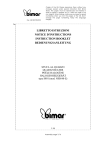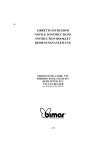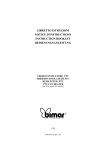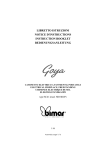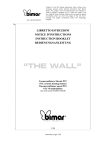Download Bimar S314.EU space heater
Transcript
Fax +32 030 9904733 Copies of the I/B. Please reproduce them without any changes except under special instruction from Bimar (Italy). The pages must be reproduced and folded in order to obtain a booklet A5 (+/- 148.5 mm width x 210 mm height). When folding, make sure you keep the good numbering when you turn the pages of the I/B. Don’t change the page numbering. Keep the language integrity. LIBRETTO ISTRUZIONI NOTICE D'INSTRUCTIONS INSTRUCTION BOOKLET BEDIENUNGSANLEITUNG TERMOVENTILATORE FAN HEATER THERMOVENTILATEUR HEIZLÜFTER Type S314-S315 (mod.????) 1/20 Assembly page 1/20 Fax +32 030 9904733 Fig.1 mod.S314 (versione base) Copies of the I/B. Please reproduce them without any changes except under special instruction from Bimar (Italy). The pages must be reproduced and folded in order to obtain a booklet A5 (+/- 148.5 mm width x 210 mm height). When folding, make sure you keep the good numbering when you turn the pages of the I/B. Don’t change the page numbering. Keep the language integrity. Fig.2 mod.S315 (versione con programmatore 24h) I I A. B. C. D. Interruttore oscillazione Interuttore ionizzante Manopola selettore Manopola termostato A. B. C. D. Oscillating switch Ionic Switch Selector Knob Thermostat Knob A. B. C. D. Interrupteur d'oscillation Interuttore ionizzante Bouton du sélecteur Bouton du thermostat A. B. C. D. Oszillationsschalter Interuttore ionizzante Wahlschalter Thermostatknopf UK A. B. C. D. E. F. Interruttore oscillazione Interuttore ionizzante Manopola selettore Manopola termostato Orologio programmatore 24h Pulsante “I/ ” A. B. C. D. E. F. Oscillating switch Ionic Switch Selector Knob Thermostat Knob Timer 24 hours Switch “I/ ” A. B. C. D. E. F. Interrupteur d'oscillation Ionisant Interrupteur Bouton du sélecteur Bouton du thermostat Programmateur 24 heures Bouton “I/ ” A. B. C. D. E. F. Oszillationsschalter Ionisierende schalter Wahlschalter Thermostatknopf 24-Stunden-Zeitschaltuhr Schalter “I/ ” UK F F D D 2/20 Assembly page 2/20 Fax +32 030 9904733 Copies of the I/B. Please reproduce them without any changes except under special instruction from Bimar (Italy). The pages must be reproduced and folded in order to obtain a booklet A5 (+/- 148.5 mm width x 210 mm height). When folding, make sure you keep the good numbering when you turn the pages of the I/B. Don’t change the page numbering. Keep the language integrity. Questo simbolo vi invita a leggere attentamente queste istruzioni prima dell’uso dell’apparecchio, ed eventualmente informare terzi, se necessario. CONSERVARE IL LIBRETTO PER ULTERIORI CONSULTAZIONI. Questo simbolo vi invita a prestare attenzione, ed a leggere gli specifici avvertimenti sul libretto istruzioni. AVVERTENZE • Questo apparecchio è destinato solo al riscaldamento di ambienti interni domestici e similari, secondo le modalità indicate in queste istruzioni; è da considerarsi inoltre apparecchio supplementare di riscaldamento, e non come impianto di riscaldamento centrale. L’apparecchio Non deve essere utilizzato in ambienti polverosi o con materiali estremamente volatili (potrebbero oustruire griglie o scambiatiore di calore), o in ambienti con elevata umidità, o con prodotti infiammabili, o in ambienti esterni (all’aperto).Ogni altro uso è da considerarsi improprio e pericoloso. Il costruttore non potrà essere ritenuto responsabile di eventuali danni derivanti da uso improprio, erroneo e irresponsabile e/o da riparazioni effettuate da personale non qualificato. • Quando il termoventilatore è in funzione si scalda, quindi toccare soltanto la maniglia e le manopole in plastica. Evitare il contatto con la griglia forntale perchè molto calda. Non inserire le dita e/o nessun oggetto attraverso la griglia frontale, per evitare abrasioni, scosse elettriche, o danni all’apparecchio. • Controllate che il termoventilatore non venga in contatto con l’acqua o altri liquidi. Nel caso dovesse succedere non immergere la mano nel liquido ma per prima cosa togliere la spina dalla presa di corrente. Asciugare con cura l’apparecchio e verificare che tutte le parti elettriche siano asciutte: in caso di dubbio rivolgersi a personale professionalmente qualificato. • In caso di caduta o cattivo funzionamento, scollegare immediatamente il cordone elettrico. Verificare che nessuna parte sia danneggiata, e dopo questi accertamenti accenderlo: in caso di dubbio rivolgersi a personale professionalmente qualificato. • Non utilizzare l’apparecchio per asciugare indumenti. • Non toccare l’apparecchio con mani o piedi bagnati. • L’apparecchio non è destinato a essere usato da persone (bambini compresi) le cui capacità fisiche, sensoriali o mentali siano ridotte, oppure con mancanza di esperienza o di conoscenza, a meno che esse abbiano potuto beneficiare, attraverso l’intermediazione di una persona responsabile della loro sicurezza, di una sorveglianza o di istruzioni riguardanti l’uso dell’apparecchio. I bambini devono essere sorvegliati per sincerarsi che non giochino con l’apparecchio. • L’apparecchio deve essere mantenuto fuori dalla portata di bambini. • Attenzione: quando si utilizzano apparecchi elettrici, occorre sempre rispettare le precauzioni di sicurezza di base per evitare i rischi di incendio, di scosse elettriche e di lesioni fisiche. • La griglia di protezione non fornisce completa protezione a bambini o a persone con ridotte capacità fisiche, sensoriali o mentali. • Se l’apparecchio non è in funzione togliere la spina dalla presa di corrente. • L'utilizzatore non deve lasciare l’apparecchio senza sorveglianza quando è collegato all'alimentazione. • Non lasciare l’apparecchio esposto agli agenti atmosferici (sole, pioggia, ecc.). • Non tirare il cavo di alimentazione o l’apparecchio stesso per disinserire la spina dalla presa di corrente. • Al fine di evitare ogni rischio di scossa elettrica, non immergere mai la spina, il cordone elettrico e l’apparecchio nell’acqua od in nessun altro liquido. • Non usare l’apparecchio se non funziona correttamente o se sembra danneggiato; in caso di dubbio rivolgersi a personale professionalmente qualificato. 3/20 Assembly page 3/20 Fax +32 030 9904733 Copies of the I/B. Please reproduce them without any changes except under special instruction from Bimar (Italy). The pages must be reproduced and folded in order to obtain a booklet A5 (+/- 148.5 mm width x 210 mm height). When folding, make sure you keep the good numbering when you turn the pages of the I/B. Don’t change the page numbering. Keep the language integrity. • Se il cavo di alimentazione è danneggiato, esso deve sostituito dal costruttore o dal suo servizio assistenza tecnica o comunque da una persona con qualifica similare, in modo da prevenire ogni rischio. Questo simbolo indica: ATTENZIONE: per evitare il surriscaldamento non coprire l’apparecchio. INSTALLAZIONE • Dopo aver tolto l’imballaggio, assicurarsi dell’integrità dell’apparecchio; in caso di dubbio non utilizzarlo e rivolgersi a personale professionalmente qualificato. Gli elementi di imballaggio (sacchetti in plastica, polistirolo espanso, chiodi, ecc.) non devono essere lasciati alla portata di mano di bambini in quanto potenziali fonti di pericolo. Attenzione: eventuali talloncini/etichette pubblicitari attaccati a manopole o manigle, devono essere rimossi prima di utilizzare l’apparecchio. • Prima di collegare l’apparecchio controllare che i valori di tensione riportati sulla targa dati corrispondano a quelli della rete elettrica (230V~ 50Hz). In caso di incompatibilità tra la presa e la spina dell’apparecchio, far sostituire la presa con altra di tipo adatto da personale professionalmente qualificato, il quale accerti che la sezione dei cavi della presa sia idonea alla potenza assorbita dall’apparecchio (10A). Verificare che sulla linea elettrica non siano collegati altri apparecchi ad elevato assorbimento, per evitare sovraccarichi e rischi di incendio. In generale è sconsigliato l’uso di adattatori e/o prolunghe; se il loro uso si rendesse indispensabile, devono essere conformi alle vigenti norme di sicurezza e la loro portata di corrente (ampères) non deve essere inferiore a quella massima dell’apparecchio. • Prima di ogni utilizzo verificare che l’apparecchio sia in buono stato, che il cordone elettrico non sia danneggiato: in caso di dubbio rivolgersi a personale professionalmente qualificato. • Assicurarsi che il cavo sia posizionato correttamente e che non sia a contatto con parti calde o spigoli taglienti, né avvolto intorno all’apparecchio o attorcigliato su se stesso. • La presa di corrente deve essere facilmente accessibile in modo da poter disinserire con facilità la spina in caso di emergenza. • Posizionare il termoventilatore lontano da altre fonti di calore, da materiali infiammabili (tende, tappezzerie, ecc.), da gas infiammabili o materiale esplosivo (bombolette spray) e da materiali che possono deformarsi con il calore. Verificare che lo spazio libero sia di 120 cm dalla parte frontale del termoventilatore e 50 cm ai lati e retro. • Non utilizzare l’apparecchio nelle immediate vicinanze di una vasca da bagno, di una doccia o di una piscina (per evitare che gocce d’acqua possono cadere sull’apparecchio e che lo stesso possono cadere in acqua), ne in luoghi dove possa subire urti. • L’apparecchio non deve essere posizionato immediatamente al di sotto di una presa di corrente. • Non appendere l’apparecchio al muro. • La superficie d’appoggio deve essere stabile, ampia (sono da escludere mensole), non in pendenza (in quanto l’apparecchio potrebbe ribaltarsi). • Assicurarsi che la ventola funzioni correttamente: nel caso contrario spegnere l’apparecchio e farlo controllare da personale professionalmente qualificato. • Assicurarsi che l’elemento riscaldante sia libero da polvere, lanugine, o quant’altro simile: migliora la resa del termoventilatore, e si impedisce il surriscaldamento dell’apparecchio. Verificare periodicamente la che la griglia di aspirazione non venga ostruita da oggetti, tessuti o altro per evitare il surriscaldamento o la rottura dell’apparecchio. • Questo apparecchio non è destinato a essere fatto funzionare per mezzo di un temporizzatore esterno o con un sistema di comando a distanza separato, per evitare il rischio di incendio nel caso l’apparecchio sia coperto o sia posizionato in modo non corretto. 4/20 Assembly page 4/20 Fax +32 030 9904733 Copies of the I/B. Please reproduce them without any changes except under special instruction from Bimar (Italy). The pages must be reproduced and folded in order to obtain a booklet A5 (+/- 148.5 mm width x 210 mm height). When folding, make sure you keep the good numbering when you turn the pages of the I/B. Don’t change the page numbering. Keep the language integrity. • In caso di guasto o cattivo funzionamento spegnere l’apparecchio e farlo controllare da personale professionalmente qualificato; le riparazioni effettuate da personale non qualificato possono essere pericolose e fanno decadere la garanzia. FUNZIONAMENTO Prima di ogni utilizzo verificare che l’apparecchio sia in buono stato, che il cordone elettrico non sia danneggiato: se il cavo di alimentazione è danneggiato, esso deve sostituito dal costruttore o dal suo servizio assistenza tecnica o comunque da una persona con qualifica similare, in modo da prevenire ogni rischio. mod. S314 versione base (Fig.1) L’apparecchio è dotato di termostato, selettore, funzione ionizzante e oscillazione destra-sinistra: - il selettore regola le seguenti funzioni: “0”= spento; “ ”= ventilazione; “I”= aria calda (1000W); “I I”= aria molto calda (2000W) - il termostato regola la temperatura ambiente, e sarà maggiore quanto più la manopola è ruotata verso la pos. di massimo (senso orario): raggiunta la temperatura verrà mantenuta costante - funzione ionizzante: produce un flusso di ioni negativi che neutralizzano ioni positivi presenti l’aria, la funzione ionizzante è meno evidente in ambienti con alto tasso di umidità, questa funzione è attiva ogni volta che si preme il pulsante (B) - oscillazione destra-sinistra: premere il pulsante d’oscillazione (TURN), per far roteare l’apparecchio a destra e a sinistra Per l’impiego del termoventilatore si operi nel modo seguente: 1) Inserire la spina nella presa di corrente: la spia luminosa si accende, segnalando la presenza di tensione. 2) Regolare la manopola del termostato (C) alla temperatura ambiente desiderata. 3) Accendere l’apparecchio ruotando in senso orario il selettore (D) in corrispondente alla funzione desiderata. 4) Selezionare (se desiderato) le funzioni oscillazione “TURN” (A) e ionizzante “IONIC” (B) agendo sugli appositi tasti. 5) Per spegnere l’apparecchio, ruotare il selettore in posizione “0” e togliere la spina dalla presa di corrente. Per lunghi periodi di inattività, togliere la spina dalla presa di corrente. mod. S315 con programmatore 24 ore (Fig.2) L’apparecchio è dotato di selettore, termostato, programmatore 24 ore, funzione ionizzante e oscillazione destra-sinistra. Le funzioni del selettore, del termostato, funzione ionizzante e oscillazione destra-sinistra sono descritte nel par. precedente; il programmatore consente di regolare nell’arco delle 24 ore, periodi di “acceso” e “spento” del termoventilatore, e di ripeterli sistematicamente ogni giorno. Il programmatore è attivo quando il tasto (F) posto al suo fianco è in corrispondenza del simbolo ” ”, se è in corrispondenza del simbolo “I” il programmatore è escluso. Per l’impiego del termoventilatore si operi così come è descritto nei punti 1 e 2 del precedente paragrafo. Inoltre: a) Funzionamento con programmatore escluso (tasto pos. “I”). a1) Ruotare il selettore in corrispondenza alla pos. “I” o “I I”; l’apparecchio si accende. a2) Per spegnere l’apparecchio ruotare il selettore nella pos. “0”,e togliere la spina dalla presa di corrente. b) Funzionamento con programmatore (tasto pos. ). b1) Impostare l’ora esatta: ruotare il disco del programmatore nel senso indicato dalla freccia facendo così coincidere l’ora esatta con l’indice di riferimento. 5/20 Assembly page 5/20 Fax +32 030 9904733 Copies of the I/B. Please reproduce them without any changes except under special instruction from Bimar (Italy). The pages must be reproduced and folded in order to obtain a booklet A5 (+/- 148.5 mm width x 210 mm height). When folding, make sure you keep the good numbering when you turn the pages of the I/B. Don’t change the page numbering. Keep the language integrity. b2) Le funzioni di acceso/spento sono regolate dai tastini della corona: se orientati all’interno l’apparecchio rimane spento, se orientati all’esterno si accende; spingere il tastino per posizionarlo nell’uno o nell’altro modo (1 tastino corrisponde a 30 minuti ). Regolare la posizione dei tastini in corrispondenza all’orario in cui si desidera il termoventilatore acceso (tasto all’esterno) o spento (tasto al centro): a questo punto sono visibili sulla corona dei segmenti che corrispondono ai periodi di acceso e spento. Il programmatore ripeterà le stesse funzioni sino a quando non sono modificate o sino a quando il tasto rimane nella pos. “ ”. b3) Selezionare (se desiderato) le funzioni oscillazione “TURN” (A) e ionizzante “IONIC” (B) agendo sugli appositi tasti. b4) Per spegnere il termoventilatore in modo definitivo portare il tasto su “I” ruotare il selettore in pos. “0” (la spia si spegne) e togliere la spia dalla presa di corrente. Per lunghi periodi di inattività, togliere la spina dalla presa di corrente. PULIZIA E MANUTENZIONE Attenzione: prima di pulire l’apparecchio spegnerlo, disinserire la spina dalla presa di corrente ed attendere che si sia raffreddato. • Assicurarsi periodicamente che la griglia di aspirazione posteriore non risulti ostruita da lanugine o sfilacci. • Per la pulizia del corpo utilizzare un panno morbido leggermente umido; non utilizzare pagliette metalliche o prodotti abrasivi. • Per la pulizia della griglia di aspirazione, impiegare eventualmente l’aspirapolvere facendo attenzione a non danneggiare la resistenza elettrica. • Per la sostituzione del cordone elettrico necessita un utensile speciale: rivolgersi ad un centro assistenza autorizzato anche per eventuali riparazioni. • Quando non si utilizza l’apparecchio è necessario coprirlo e riporlo in un luogo asciutto; è consigliabile confezionarlo con l’imballo originale per proteggerlo dalla polvere e dall’umidità. • Se si decide di non utilizzare più l’apparecchio, si raccomanda di renderlo inoperante tagliando il cavo di alimentazione (prima assicurarsi d’aver tolto la spina dalla presa di corrente), e di rendere innocue quelle parti che sono pericolose qualora utilizzate per gioco dai bambini. • Non disperdere nell’ambiente prodotti non biodegradabili, ma smaltirli nel rispetto delle norme vigenti. Alla fine della sua vita utile il prodotto non deve essere smaltito insieme ai rifiuti urbani. Può essere consegnato presso gli appositi centri di raccolta differenziata predisposti dalle amministrazioni comunali, oppure presso i rivenditori che forniranno questo servizio all’acquisto di un nuovo apparecchio. Smaltire separatamente un elettrodomestico consente di evitare possibili conseguenze negative per l’ambiente e per la salute derivanti da un suo smaltimento inadeguato e permette di recuperare i materiali di cui è composto al fine di ottenere un importante risparmio di energia e risorse. Per rimarcare l’obbligo di smaltire separatamente gli elettrodomestici, sul prodotto è riportato il marchio del contenitore di spazzatura mobile barrato. Si tenga presente che: il corpo, manopola e la maniglia sono in plastica; I conduttori elettrici sono in rame rivestito in gomma. - Il motorino elettrico è composto da ferro e rame. La resistenza elettrica è in ferro. 6/20 Assembly page 6/20 Fax +32 030 9904733 Copies of the I/B. Please reproduce them without any changes except under special instruction from Bimar (Italy). The pages must be reproduced and folded in order to obtain a booklet A5 (+/- 148.5 mm width x 210 mm height). When folding, make sure you keep the good numbering when you turn the pages of the I/B. Don’t change the page numbering. Keep the language integrity. Please read these instructions carefully before using the appliance, and instruct other persons using it, too, when necessary. Keep booklet handy for further use. GENERAL ADVISE • This appliance is destined only to the heating of domestic or similar environments and in compliance with these instructions. It can be considered only a supplementary source of heating and not as a central heating element. The appliance must not be used in dusty environments or in the presence of extremely volatile materials which could obstruct grids or heat exchanger, nor in very damp environments, in the presence of inflammable products, or out of doors in the open. Any other use is to be considered inappropriate and therefore dangerous. The manufacturer cannot be held responsible for eventual damage caused by inappropriate, improper or irresponsible use and/or for repairs made to the product by unauthorised personnel. • The fan heater gets hot when working; so only touch the handle and plastic Knobs. Avoid contact with the heating element. • Ensure that the heating fan does not come into contact with water or other liquids. If this should happen, never immerse hands in the liquid but remove the plug from the socket first of all. Dry the appliance carefully and check that all the electric parts are dry. If in doubt, call a qualified expert. • If the appliance should fall over or shows signs of faulty operation, disconnect the electrical cable immediately. Check that no part is damaged and switch it on after the appliance has been thoroughly checked: in case of doubt, contact qualified professional personnel. • This appliance is not intended for use by persons (including children) with reduced physical, sensory or mental capabilities, or lack of experience and knowledge, unless they have been given supervision or instruction concerning use of the appliance by a person responsible for their safety. Children should be supervised to ensure that they do not play with the appliance. • The appliance must be kept out of children’s reach. • Attention: when using electric appliances, the basic safety precautions must always be observed to avoid risks of fire, electric shocks and physical injury. • Unplug the appliance when not in use. • The fireguard of this heater is intended to prevent direct access to heating elements and must be in place when the heater is in use, but the fireguard does not give full protection for young children and for infirm person. • That the user must not leave the appliance unattended while it is connected to the supply. • Do not touch the heater with wet hands or feet. • Never use the radiator to dry damp garments. • Do not expose the heater to the weather (sun, rain, etc.). • Do not pull on the power cord or the appliance to unplug the appliance from the wall socket. Never move the appliance by pulling the cord. • If the electric cord is damaged, it has to be replaced by the supplier or an authorized service center or a professionally qualified, to avoid any risks. This symbol show: ATTENTION do not cover the appliance when it is operating to avoid the risk of fires. INSTALLATION • After removing the packing materials, check the integrity of the heater; if you are unsure, do not use it and ask for qualified professional help. The packing materials (plastic bags, polystyrene foam, nails, etc.) must be kept out the reach of children because they are potential sources of danger. 7/20 Assembly page 7/20 Fax +32 030 9904733 Copies of the I/B. Please reproduce them without any changes except under special instruction from Bimar (Italy). The pages must be reproduced and folded in order to obtain a booklet A5 (+/- 148.5 mm width x 210 mm height). When folding, make sure you keep the good numbering when you turn the pages of the I/B. Don’t change the page numbering. Keep the language integrity. • Before connecting the appliance, check that the voltage shown on the data plate matches that of your electricity and that the electric plug is grounded (230V~ 50Hz). In the event of incompatibility between the electric outlet and the plug of the heater, have the outlet replaced with another more suitable type by professionally qualified personnel, who will make sure that the section of the wires of the outlet is appropriate for the absorbed power of the heater (10A). In general, the use of adapters or extension cords is not recommended; if their use is indispensable, they must conform to existing safety standards and their current capacity (amperes) must not be less that the maximum of the heater. Attention: before use the appliance remove the detachable coupon to stick the handle. • Before each use, verify that the heater is in good condition and that the electrical cord is not damaged: in the case of doubt, ask for professionally qualified help. • Make sure that the cable is correctly positioned and that it is not in contact with hot parts or sharp edges, nor wrapped around the device or twisted. • The power socket must be easy to reach so the plug can be removed quickly in case of emergency. • Position the fan heater far from other sources of heat, inflammable materials (curtains, carpets, etc.), inflammable gases or explosive materials (spray cans) and from materials that can deform on exposure to heat. Make sure that there is 100 cm of free space in front of the fan heater and 30 cm on the sides. Do not use the heater in the immediate vicinity of a bathtub, shower or swimming pool (to avoid drops of water falling on the heater or the heater falling in the water), or in places where it could be subject to shocks. • Don’t hang it on the wall. • Make sure that the fan heater is working correctly: if not, turn the heater off and have it checked by professionally qualified personnel. • Make sure that the air-intake grid is not obstructed by objects, fabrics or anything else to avoid the heater overheating or breaking. • Do not use the appliance with a timer or a programmer or with a system that can switch on the appliance automatically, to avoid risk of fire, since a fire risk exists if the heater is covered or positioned incorrectly. • In the case of a breakdown or fault, switch off the appliance and have it checked by a professionally qualified technician; repairs made by unqualified persons can be dangerous and render void the warranty. USE Before each use, verify that the unit is in good condition, the electric cord is not damaged, if the power cord is damaged, it must be replaced by the manufacturer or a competent qualified electrician or a person with similar qualifications, in order to avoid any risk. mod. S314 basic version (Fig.1) The fan-heater is fitted with switch, thermostat, Ionising function and left-right oscillation: - the switch sets following functions: “0”= OFF; “ ”= fan; “I”= = air warm (1000W); “I I”= air very hot (2000W) - the thermostat sets the room temperature, that will be higher if the knob is rotated to position max clockwise: when the temperature is reached, it will be kept uniform - Ionising function: this produces a flow of negative ions which neutralise the positive ions in the air; the ionising function is less evident in environments with high levels of humidity, this fuction is On then is selected the button (B) - left-right oscillation: switch on the key for the swinging (TURN) to let the stove swing to the left and to the right. To use the thermofan, please follow the instructions below: 1) Insert the plug in the current socket: the pilot light on, comes on indicating the presence of voltage. 8/20 Assembly page 8/20 Fax +32 030 9904733 Copies of the I/B. Please reproduce them without any changes except under special instruction from Bimar (Italy). The pages must be reproduced and folded in order to obtain a booklet A5 (+/- 148.5 mm width x 210 mm height). When folding, make sure you keep the good numbering when you turn the pages of the I/B. Don’t change the page numbering. Keep the language integrity. 2) 3) Turn the thermostat knob clockwise to the position corresponding to the desired temperature: To switch the appliance on, turn the selector knob (D) to the position corresponding to the desired function. 4) If desired, select the “TURN”(A) and ionizing”IONIC” (B) functions using the buttons. 5) To turn the appliance off, rotate the knob to position “0” and take the plug out of the socket. Never leave the appliance connected to the socket if it is not in use, especially for long periods. Mod. S315 with 24 hour programmer (Fig.2) The appliance has a switch, a thermostat and a 24 hour programmer, Ionising function and left-right oscillation. The functions of the switch and thermostat are described in the previous paragraph; the programmer permits fan heater “on” and “off” periods to be set during a 24 hour period, and of repeating them systematically, day-after-day. The programmer is active when the button (F) on its side is aligned with the ” ” symbol; if it is aligned with the “I” symbol, the programmer is excluded. To use the fan heater, act as described in points 1 and 2 of the previous paragraph. Also: a) Operating with the programmer excluded (button pos. “I”). a1) Turn the switch to line up with position “I” or “I I”; the appliance comes on as does the luminous pilot light. a2) To switch off the appliance, turn the switch to pos. “0” (the pilot light goes out) and remove the plug from the current socket. b) Operating with the programmer (button pos. ). b1) Set the right time: rotate the disc of the timer in the direction shown by the arrow meeting the right time with the reference dial. b2) The on/off functions are regulated by small buttons on the crown: if directed inwards, the appliance remains switched off – if directed outwards it switches on. Push the button in one way or another (1 button corresponds to 30 minutes). Adjust the position of the buttons to the times you want the fan heater on (button to the outside) or off (button to the centre): at this point, segments corresponding to the on and off periods are visible under the crown. The programmer will repeat the same functions until they are modified or until the button remains in the “ ” position. b3) If desired, select the “TURN”(A) and ionizing”IONIC” (B) functions using the buttons. b4) To switch off the fan heater definitively, bring the button to “I”, rotate the selector to the “0” and take the plug out of the socket. Never leave the appliance connected to the socket if it is not in use, especially for long periods. CLEANING AND MAINTENANCE Attention: before cleaning the appliance, turn it off, remove the plug from the outlet and wait for it to cool. • Periodically check that the air-intake grill is not obstructed by fuzz or threads. • Use a soft, slightly damp cloth to clean the body; do not use metal scouring pads or abrasive products. • To clean and maintain of the grid, it is possible vacuum cleaner paying attention not to damage the electrical resistance. • A special tool is required to replace the electrical cord: contact an authorized service center, also for any repairs. • When the appliance is not being used, cover it and put it in a dry place. it is a good idea to put it back in its original packaging to protect it from dust and humidity. • If you decide not to use the fan heater, we recommend that you make it inoperative by cutting the power cord (but first make sure you have removed the plug from the electrical outlet), and make those parts harmless that are dangerous when played with by children. 9/20 Assembly page 9/20 Fax +32 030 9904733 Copies of the I/B. Please reproduce them without any changes except under special instruction from Bimar (Italy). The pages must be reproduced and folded in order to obtain a booklet A5 (+/- 148.5 mm width x 210 mm height). When folding, make sure you keep the good numbering when you turn the pages of the I/B. Don’t change the page numbering. Keep the language integrity. • Do not dispose of non-biodegradable products in the environment but dispose of them in accordance with current law. At the end of its working life, the product must not be disposed of as urban waste. It must be taken to a special local authority differentiated waste collection centre or to a dealer providing this service. Disposing of a household appliance separately avoids possible negative consequences for the environment and health deriving from inappropriate disposal and enables the constituent materials to be recovered to obtain significant savings in energy and resources. Bear in mind that: the body, the electrical wires are copper coated in rubber. – The electric motor is made of iron and copper. The electrical resistance is made of iron. 10/20 Assembly page 10/20 Fax +32 030 9904733 Copies of the I/B. Please reproduce them without any changes except under special instruction from Bimar (Italy). The pages must be reproduced and folded in order to obtain a booklet A5 (+/- 148.5 mm width x 210 mm height). When folding, make sure you keep the good numbering when you turn the pages of the I/B. Don’t change the page numbering. Keep the language integrity. Nous vous prions de lire attentivement ces instructions avant d’utiliser l'appareil et de les divulguer à toutes les personnes qui pourraient en avoir besoin. GARDEZ-LES A PORTEE DE MAIN. RECOMMANDATIONS • Cet appareil est uniquement destiné au chauffage domestique et semblable et doit être utilisé conformément aux présentes instructions. Il s’agit d’un appareil de chauffage d'appoint, et non pas d’une installation de chauffage central. Ne pas l’utiliser dans des endroits poussiéreux ou en présence de matières extrêmement volatiles (qui pourraient obstruer les grilles ou l'échangeur de chaleur) ou dans des endroits très humides, en présence de produits inflammables ou à l'extérieur. Tout autre usage est considéré comme inopportun et donc dangereux. Aucune responsabilité ne peut être engagée pour des détériorations dues à une utilisation inappropriée ou non conforme au mode d’emploi et/ou pour des réparations faites par du personnel non autorisé. • Quand le thermoventilateur est en service, il se réchauffe et il faut par conséquent toucher seulement les poignée et bouton en matière plastique. Eviter le contact avec la partie chauffante. • S'assurer que le thermoventilateur n'entre pas en contact avec de l’eau ou d'autres liquides. Si cela devait arriver, ne pas plonger la main dans le liquide, mais commencer par enlever la fiche de la prise secteur. Sécher l’appareil avec soin et vérifier que toutes les parties électriques sont bien sèches : en cas de doute, s’adresser à un réparateur qualifié. • Vérifier si le thermoventilateur n’est pas en contact avec de l’eau ou d’autres liquides. Si par mégarde il devait se baigner ou s’immerger dans le liquide, enlever immédiatement la fiche de la prise de courant, sécher soigneusement et vérifier que le liquide ne soit pas entré à l’intérieur ; en cas de doute, s’adresser au personnel professionnellement qualifié. • Ne pas toucher l’appareil avec les mains ou les pieds mouillés. • Ce produit n’est pas prévu pour être utilisé par des personnes (y compris les enfants) possédant des capacités physiques, sensorielles ou mentales réduites ou bien une expérience et connaissance insuffisante, à moins qu’elles ne se trouvent sous la surveillance de quelqu’un ou qu’elles n’aient reçu des instructions concernant l’utilisation de l’appareil de la part des personnes responsables de leur sécurité. Il convient de surveiller les enfants pour s’assurer qu’ils ne jouent pas avec l’appareil. • Tenir hors de portée des enfants. • Attention : lorsque vous utilisez des appareils électriques, respectez toujours les consignes de sécurité élémentaires, afin d’éviter tout risque d'incendie, de décharge électrique ou de lésion corporelle. • Ne déplacez pas le l’appareil quand il est en train de fonctionner. • La grille de protection n’est pas une protection fiable à 100 % pour les enfants ou les personnes ayant des capacités physiques, sensorielles ou mentales réduites. • Ne laissez jamais votre appareil sans surveillance lorsque celui-ci est sous tension. • Evitez d’utiliser le radiateur pour sécher le linge. • Ne laissez jamais votre appareil sans surveillance lorsque celui-ci est sous tension. • Ne pas laisser l’appareil exposé aux agents atmosphériques (soleil, pluie, etc.) • Ne pas tirer le câble d’alimentation ou l’appareil lui-même pour débrancher la fiche de la prise de courant. • Si le câble est endommagé, il doit être obligatoirement remplacé par un service qualifié compétent ou par une personne qualifiée. Ce symbole indique: ATTENTION ne couvrez pas l’appareil lorsque celui-ci est en fonctionnement afin d’éviter les risques d’incendie. 11/20 Assembly page 11/20 Fax +32 030 9904733 Copies of the I/B. Please reproduce them without any changes except under special instruction from Bimar (Italy). The pages must be reproduced and folded in order to obtain a booklet A5 (+/- 148.5 mm width x 210 mm height). When folding, make sure you keep the good numbering when you turn the pages of the I/B. Don’t change the page numbering. Keep the language integrity. INSTALLATION • Après avoir enlevé l’emballage, s’assurer de l’intégrité de l’appareil; en cas de doute, ne pas l’utiliser et s’adresser à un personnel qualifié professionnellement. On ne doit pas laisser les éléments d’emballage (sachets en matière plastique, polystyrène expansé, clous, etc...) à portée de main des enfants étant donné que ce sont des sources de danger potentielles. Attention: enlever le coupon attaché à poignée avant d'utiliser l'appareill. • Avant d'utiliser l'appareil, vérifiez que la tension du réseau corresponde bien à celle indiquée sur la plaque signalétique de l'appareil (230V~ 50Hz). En cas d'incompatibilité entre la prise et la fiche de l'appareil, faites remplacer le cordon d'alimentation par un service qualifié compétent qui devra s'assurer que la tension du cordon corresponde à la tension du réseau électrique (10A). En général l'utilisation d'adaptateurs ou de rallonges est déconseillée; cependant, s'il s'avère indispensable d'en utiliser, ils doivent être conformes aux normes de sécurité en vigueur et leur ampérage ne peut pas être inférieur au maximum de l'appareil. • Avant chaque utilisation, vérifier si l’appareil est en bon état, si le cordon électrique n’est pas endommagé: en cas de doute, il faut s’adresser au personnel qualifié professionnellement. • Il faut s’assurer que le câble est bien placé correctement et qu’il n’est pas en contact avec des parties chaudes ou des arêtes tranchantes, ni enroulé autour de l’appareil ou entortillé sur lui-même. • La prise secteur doit être facile d’accès afin de pouvoir débrancher facilement l’appareil en cas d'urgence. • Placer le thermoventilateur loin des autres sources de chaleur, loin des matériaux inflammables (rideaux, tapisseries, etc.), des gaz inflammables ou d’une matière explosive (petites bouteilles spray) et des matériaux qui peuvent se déformer avec la chaleur. Vérifier si l’espace libre est de 100 cm à partir de la partie frontale du thermoventilateur et de 30 cm à partir des côtés. Ne pas utiliser l’appareil dans le voisinage immédiat d’une baignoire, d’une douche ou d’une piscine (pour éviter que des gouttes d’eau ne tombent sur l’appareil qui peut lui-même tomber dans l’eau), ni dans des lieux où il puisse subir des chocs. • L’appareil ne doit jamais être positionné directement sous une prise électrique. • Ne l'accrochez pas au mur. • La surface d’appui doit être stable (exclure l'étagère), pas inclinée (étant donné que l’appareil pourrait se renverser). • Il faut s’assurer que la grille d’aspiration ne puisse pas s’obstruer avec des objets, des tissus ou d’autres choses afin d’éviter la surchauffe ou la rupture de l’appareil. • N'utilisez pas l'appareil avec une minuterie ou un programmateur ou avec un système qui peut mettre l'appareil en marche automatiquement, pour éviter tout risque d'incendie si l’appareil est couvert ou situé en position non appropriée. • En cas de panne ou de mauvais fonctionnement, éteindre l’appareil et le faire contrôler par un personnel qualifié professionnellement. FONCTIONNEMENT Avant chaque utilisation, vérifiez que l'appareil est en bon état, le cordon électrique (5) n'est pas endommagé, si le cordon d'alimentation est endommagé, il doit être remplacé par le fabricant ou son agent de service ou par une personne des qualifications semblables, afin d'éviter tout risque. mod. S314 version base (Fig.1) L’ appareil est équipé d’un thermostat, d’un sélecteur, fonction ionisante et oscillation droite et gauche : - le sélecteur règle les fonctions suivantes: “0”= éteint; “ ”= ventilation; “I”= air chaud (1000W); “I I”= air très chaud (2000W) - Le thermostat règle la température du milieu, et plus on fera tourner la poignée vers la position de maximum (sens des aiguilles d’une montre), plus la température du thermostat sera élevée: lorsque la température sera atteinte, elle sera maintenue constante. 12/20 Assembly page 12/20 Fax +32 030 9904733 Copies of the I/B. Please reproduce them without any changes except under special instruction from Bimar (Italy). The pages must be reproduced and folded in order to obtain a booklet A5 (+/- 148.5 mm width x 210 mm height). When folding, make sure you keep the good numbering when you turn the pages of the I/B. Don’t change the page numbering. Keep the language integrity. - Fonction ionisante : elle produit un flux d'ions négatifs qui neutralisent les ions positifs présents dans l’air. La fonction ionisante est moins facile à obtenir lorsque le taux d'humidité est élevé, pour l'obtenir, appuyer sur le bouton (B) - Mettez l'oscillation en marche à l'aide de son interrupteur (TURN) pour faire pivoter le chauffage vers la gauche et vers la droite En ce qui concerne l’emploi, on procède de la façon suivante: 1) Insérer la fiche dans la prise de courant. Le témoin, s'allume pour signaler la présence de tension. 2) Tourner le bouton du thermostat (C) dans le sens des aiguilles d'une montre jusqu'à la position correspondant à la température souhaitée. 3) Pour mettre l’appareil en marche, tourner le bouton sélecteur (D) jusqu'à la position correspondant à la fonction souhaitée. 4) Sélectionner si désiré les fonctions «SWING» (A) et ionisante « IONIC » gissant sur les touches buttons. 5) Pour éteindre l’appareil, faire tourner le sélecteur sur la position “0” et enlever la fiche de la prise de courant. En cas d'inutilisation prolongée, débrancher la fiche de la prise de courant. Mod. S315 avec programmateur 24 heures (Fig.2) L’appareil est équipé d’un sélecteur, fonction ionisante, oscillation droite et gauche, d’un thermostat et d’un programmateur de 24 heures. Les fonctions du sélecteur et du thermostat sont décrites dans le paragraphe précédent; le programmateur permet de régler dans l’arc de 24 heures, les périodes de ”allumé” et “éteint” du, thermoventilateur, et de les répéter systématiquement chaque jour. Le programmateur est activé quand la touche (F) placée sur le côté est en correspondance du symbole ” ”, si elle est en correspondance du symbole “I”, le programmateur est exclu. Pour utiliser le thermoventilateur, on opère en suivant ce qui est décrit dans les points 1 et 2 du paragraphe précédent. En outre: a) Fonctionnement avec programmateur exclu (touche pos. “I”). a1) Faire tourner le sélecteur en correspondance de la pos.“2” ou “3”; l’appareil s’allume. a2) Pour éteindre l’appareil faire tourner le sélecteur sur la pos. “0” (la lampe témoin s’éteint) et enlever la fiche de la prise de courant . b) Fonctionnement avec programmateur (touche pos. ). b1) Sélectionner l’heure exacte: faire tourner le disque du programmateur dans le sens indiqué par la flèche en faisant coïncider de cette façon l’heure exacte avec l’indice de référence. b2) Les fonctions de allumé/éteint sont réglées par de petites touches de la couronne: s’ils sont orientés à l’intérieur, l’appareil reste éteint, s’ils sont orientés à l’extérieur, il s’allume; pousser la petite touche pour le placer d’une façon ou d’une autre (1 petite touche correspond à 30 minutes). Régler la position des petites touches en correspondance de l’horaire auquel on désire que le thermoventilateur soit allumé (touche à l’ extérieur) ou éteint(touche au centre): à ce moment-là, on peut voir des segments sur la couronne qui correspondent aux périodes d’allumé et d’éteint. Le programmateur répètera les mêmes fonctions tant que celles-ci ne sont pas modifiées ou tant que la touche reste dans la pos. “ ”. b3) Sélectionner si désiré les fonctions «SWING» (A) et ionisante « IONIC » gissant sur les touches buttons. b4) Pour éteindre le thermoventilateur d’une façon définitive, amener la touche sur ”I ” faire tourner le sélecteur sur la pos. “0” (la lampe témoin s’éteint) et enlever la fiche de la prise de courant. En cas d'inutilisation prolongée, débrancher la fiche de la prise de courant. 13/20 Assembly page 13/20 Fax +32 030 9904733 Copies of the I/B. Please reproduce them without any changes except under special instruction from Bimar (Italy). The pages must be reproduced and folded in order to obtain a booklet A5 (+/- 148.5 mm width x 210 mm height). When folding, make sure you keep the good numbering when you turn the pages of the I/B. Don’t change the page numbering. Keep the language integrity. NETTOYAGE ET ENTRETIEN Attention: avant de nettoyer l’appareil, il faut l’éteindre, débrancher la fiche de la prise de courant et attendre qu’il ait refroidi. • Il faut s’assurer périodiquement que la grille d’aspiration postérieure ne soit pas obstruée par des bourres ou des effilochures. • Pour le nettoyage du corps, utiliser un chiffon souple légèrement humide; ne pas utiliser de paillettes métalliques ou de produits abrasifs. • Quand on n’utilise pas le thermoventilateur, il faut le couvrir et le mettre dans un endroit sec; on conseille de l’envelopper dans son emballage d’origine pour le protéger de la poussière et de l’humidité. • Pour substituer le cordon électrique, il faut un outil spécial: on doit s’adresser à un centre d’assistance autorisé de même que pour d’éventuelles réparations. • Pour nettoyer et maintenir la grille d'aspiration , on peut utiliser éventuellement une aspirateur, prêtant attention de ne pas endommager la résistance électrique • Si l’on décide de ne plus utiliser l’appareil, on recommande de le rendre inopérant en coupant le câble d’alimentation (auparavant, il faut s’assurer d’avoir enlevé la fiche de la prise de courant), et de rendre inoffensives les parties qui sont dangereuses au cas où elles seraient utilisées par des enfants pour jouer. • Ne pas déverser dans l'environnement des produits qui ne sont pas biodégradables, mais les éliminer dans le respect des réglementations en vigueur. Au terme de son utilisation, le produit ne doit pas ĕtre ĕliminé avec les déchets urbains. Le produit doit ĕtre remis à l’un des centres de collecte sélective prévus par l’administration communale ou auprĕs des revendeus assurant ce service. Éliminier séparément un appareil électroménager permet d’éviter les retombées négatives pour l’environnement et la santé dérivant d’une élimination incorrecte, et permet de récupérer les matériaux qui le composent dans le but d’une économie importante en termes d’énergie et de ressources. Pour rappeler l’obligation d’éliminer séparément les appareils électroménagers, le produit porte le symbole d’un caisson à ordures barré. Veuillez garder les éléments présents à l'esprit : Le corps, buton en plastique ; les conducteurs électriques sont en cuivre revêtus de caoutchouc. – Le petit moteur électrique est composé de fer et de cuivre. La résistance électrique est composée de fer. 14/20 Assembly page 14/20 Fax +32 030 9904733 Copies of the I/B. Please reproduce them without any changes except under special instruction from Bimar (Italy). The pages must be reproduced and folded in order to obtain a booklet A5 (+/- 148.5 mm width x 210 mm height). When folding, make sure you keep the good numbering when you turn the pages of the I/B. Don’t change the page numbering. Keep the language integrity. Bitte lesen Sie vor der Benutzung des Gerätes sorgfältig diese Anleitungen und setzen Sie gegebenenfalls Dritte darüber in Kenntnis. GEBRAUCHSANLEITUNG ZUM WEITREN NACHSCHLAGEN AUFBEWAHREN. GEBRAUCHSANWEISUNGEN • Dieses Gerät ist ausschließlich dazu bestimmt, Wohnräume und Ähnliches anhand der Hinweise dieser Bedienungsanleitung zu heizen. Außerdem ist es als Zusatzheizung und nicht als Zentralheizung gedacht. Der Betrieb des Geräts ist unter folgenden Bedingungen untersagt: - in staubigen Räumen; - in Räumen, in denen sich Saugmaterial, dünne Stoffe, Papierstückchen usw. befinden (davon könnten Schutzgitter oder Wärmetauscher verstopft werden); - in Räumen mit zu hoher relativer Luftfeuchtigkeit; - im Außenbereich. Wir übernehmen keine Haftung für Schäden, welche durch unsachgemäße Behandlung entstanden sind und/oder für Reparaturen, die nicht von Fachpersonal gemacht sind. • Der Heizlüfter erwärmt sich beim Betrieb; fassen Sie ihn daher nur an den Griffen an und knopf die Kunststofftasten. Vermeiden Sie die Berührung mit dem Heizteil. • Achten Sie bitte darauf, dass der Luftkühler nicht mit Wasser oder sonstigen Flüssigkeiten in Berührung kommt. Sollte dies doch mal der Fall sein, greifen Sie bitte nicht mit der Hand in die Flüssigkeit, sondern ziehen Sie den Stecker aus der Steckdose. Das Gerät sorgfältig abtrocknen und überprüfen, ob alle elektrischen Teile trocken sind: Bei Zweifeln wenden Sie sich bitte an qualifizierte Fachkräfte. • Personen (einschließlich Kinder), die aufgrund ihrer physischen, sensorischen oder geistigen Fähigkeiten oder ihrer Unerfahrenheit oder Unkenntnis nicht in der Lage sind, das Gerät sicher zu benutzen, sollten dieses Gerät nicht ohne Aufsicht oder Anweisung durch eine verantwortliche Person benutzen. Kinder sollten beaufsichtigt werden, um sicherzustellen, dass sie nicht mit dem Gerät spielen. • Lassen Sie Ihr Gerät niemals unbeaufsichtigt, wenn es ans Stromnetz angeschlossen ist. • Berühren Sie das Gerät nie mit nassen Händen oder barfuß. • Personen (einschließlich Kinder), die aufgrund ihrer physischen, sensorischen oder geistigen Fähigkeiten oder ihrer Unerfahrenheit oder Unkenntnis nicht in der Lage sind, das Gerät sicher zu benutzen, sollten dieses Gerät nicht ohne Aufsicht oder Anweisung durch eine verantwortliche Person benutzen. Kinder sollten beaufsichtigt werden, um sicherzustellen, dass sie nicht mit dem Gerät spielen. • Das Gerät für Kinder unzulänglich aufbewahren. • Achtung: Beim Umgang mit Elektrogeräten immer die grundsätzlichen Sicherheitsmaßnahmen beachten. Damit vermeiden Sie Brandgefahr sowie die Gefahr von Stromschlägen und Körperverletzungen. • Das Schutzgitter bietet keinen vollständigen Schutz für Kinder oder Menschen mit reduzierten körperlichen, sensorischen oder geistigen Fähigkeiten. • Lassen Sie Ihr Gerät niemals unbeaufsichtigt, wenn es ans Stromnetz angeschlossen ist. • Keine Wäscheteile zum Trocknen űber das Gerät legen. • Setzen Sie das Gerät keinen Witterungseinflüssen aus (Sonne, Regen usw.). • Ziehen Sie nie am Netzkabel, sondern benutzen Sie den Netzstecker, um das Gerät vom Netz zu trennen. • Eine beschädigte Anschlussleitung muss von dem Lieferanten, von einem Kundendienst oder von einem Fachmann ausgewechselt werden. ACHTUNG: Decken Sie das Gerät niemals ab, wenn es im Betrieb ist, um Feuer zu vermeiden. 15/20 Assembly page 15/20 Fax +32 030 9904733 Copies of the I/B. Please reproduce them without any changes except under special instruction from Bimar (Italy). The pages must be reproduced and folded in order to obtain a booklet A5 (+/- 148.5 mm width x 210 mm height). When folding, make sure you keep the good numbering when you turn the pages of the I/B. Don’t change the page numbering. Keep the language integrity. INSTALLATION • Prüfen Sie nach dem Auspacken, ob das Gerät unversehrt ist; benutzen Sie im Zweifelsfall auf keinen Fall das Gerät und wenden Sie sich an eine Fachkraft. Lassen Sie das Verpackungsmaterial (Kunststoffbeutel, PS- Hartschaum, Nägel usw.) nicht in Reichweite von Kindern. Es stellt eine Gefahrenquelle für Kinder dar. Achtung: Bevor Sie dieses Gerät benutzen, vergewissern Sie sich Bitte, dass Sie den am Griff hängenden Zettel abnehmen. • Kontrollieren Sie, ob die Netzspannung mit der auf dem Gerät vermerkten Spannung übereinstimmt bevor Sie den Stecker in die Steckdose stecken (230V~ 50Hz). Die Steckdose muss geerdet sein. Im Fall einer Unvereinbarkeit zwischen dem Stecker und der Steckdose, lassen Sie die Anschlussleitung von einem Fachmann auswechseln, der sich vergewissern wird, dass die Netzspannung mit der der Anschlussleitung übereinstimmt (10A). Im Allgemeinen ist es abgeraten Verlängerungsschnur oder Adapter zu benutzen. Falls es jedoch unbedingt notwendig wäre, diese zu benutzen, vergewissern Sie sich, dass diese den geltenden Sicherheitsvorschriften entsprechen, und dass deren Stromstärke nicht niedriger ist, als die maximale Stromstärke des Gerätes. • Prüfen Sie vor jedem Gebrauch, dass das Gerät in gutem Zustand und dass das Netzkabel nicht beschädigt ist: wenden Sie sich bei Zweifeln an eine Fachkraft. • Vergewissern Sie sich, dass das Kabel korrekt verlegt ist, keine heißen Oberflächen oder scharfe Kanten berührt, dass es nicht um das Gerät gewickelt oder verknotet ist. • Die Steckdose muss leicht zugänglich sein: Damit kann der Stecker im Bedarfsfall problemlos aus der Steckdose gezogen werden. • Stellen Sie den Heizlüfter nicht in der Nähe von anderen Wärmequellen, entzündbaren Stoffen (Vorhänge, Tapeten usw.), von feuergefährlichem Gas oder explosionsgefährdetem Material (Sprühdosen usw.) oder von Gegenständen auf, die sich durch Wärmeeinwirkung verformen können. Lassen Sie einen Freiraum von 100 cm auf der Vorderseite und von 30 cm auf beiden Seiten des Gerätes. Benutzen Sie das Gerät weder in der Nähe der Badewanne, der Dusche oder eines Schwimmbads (um zu vermeiden, dass Wassertropfen auf das Gerät spritzen können oder dasselbe ins Wasser fallen kann) noch an Orten, an denen es Stößen ausgesetzt ist. • Stellen Sie das Gerät nicht gerade unterhalb einer Steckdose auf. • Kontrollieren Sie den störungsfreien Lauf des Gebläses: schalten Sie das Gerät bei einem Fehlbetrieb sofort ab und lassen Sie es von einer Fachkraft überprüfen. • Hängen Sie es nicht an einer Wand auf. • Achten Sie darauf, dass das Sauggitter nicht mit Gegenständen, Stoffen oder ähnlichem verstellt wird; das Gerät kann überhitzen und beschädigt werden. • Um Feuergefahr zu umgehen, benutzen Sie das Gerät nicht mit einer Zeitschaltuhr, einem Programmierungssystem oder mit einem System, Zum Vermeiden von Brandgefahr, falls das Gerät abgedeckt ist oder nicht ordnungsgemäß positioniert ist. • Schalten Sie das Gerät bei einem Defekt oder einer Störung ab und lassen Sie dasselbe von einer Fachkraft kontrollieren. BETRIEB DES HEIZLÜFTERS Vor jedem Einsatz überprüfen, ob das Gerät in gutem Zustand ist, das elektrische Kabel ist nicht beschädigt, wenn das Netzkabel beschädigt ist, muss es durch den Hersteller oder seinen Kundendienst oder eine Person ersetzt werden, mit ähnliche Qualifikationen, um jegliches Risiko zu vermeiden. mod. S314 Grundausführung (Abb.1) Das Gerät ist mit einem Temperaturregler, Regulierbares Thermostat, Oszillierend rechts, links und einem Wahlschalter ausgestattet. - letzterer verfügt über folgende Funktionen: “0”= Aus; “ ”= Lüftung; “I”= Warmluft (1000W); “I I”= Heißluft (2000W). 16/20 Assembly page 16/20 Fax +32 030 9904733 Copies of the I/B. Please reproduce them without any changes except under special instruction from Bimar (Italy). The pages must be reproduced and folded in order to obtain a booklet A5 (+/- 148.5 mm width x 210 mm height). When folding, make sure you keep the good numbering when you turn the pages of the I/B. Don’t change the page numbering. Keep the language integrity. - der Thermostat regelt die Raumtemperatur: drehen Sie den Schalter nach rechts auf die maximale Position; nach Erreichen der eingestellten Temperatur bleibt dieselbe konstant - Ionisierende Funktion: Zur Produktion negativer Ionen, welche die positiven Ionen in der Luft neutralisieren. Die ionisierende Funktion wird in Räumen mit hohem Feuchtigkeitsgehalt weniger stark wahrgenommen, zum Aktivieren der Schwenkbewegung müssen Sie die Taste (B). - Schalten Sie die Oszillation ein um das Heizgerät nach links (TURN) und nach rechts drehen zu lassen. Beim Gebrauch auf folgende Weise vorgehen: 1) Stecken Sie den Stecker in die Steckdose: Die Betriebsanzeige auf der Rückseite leuchtet auf und zeigt an, dass das Gerät spannungsversorgt wird 2) Den Thermostatschalter (C) auf die gewünschte Raumtemperatur drehen. 3) Zur Geräteeinschaltung drehen Sie bitte den Wählschalter auf die gewünschte Funktion (D). 4) Wählen Sie (falls Sie dies wünschen) die Funktionen “TURN” (A) und “IONIC” (B) mit den entsprechenden Tasten. 5) Zum Abschalten des Heizlüfters den Schalter auf Position “0” stellen und den Netzstecker ziehen. Bei längerem Gerätestillstand den Stecker aus der Steckdose ziehen. Mod. S315 mit 24-Stunden-Zeitschaltuhr (Abb. 2) Das Gerät ist mit einem Wahlschalter, regulierbares Thermostat, oszillierend rechts einem Temperaturregler und einer 24-Stunden-Zeitschaltuhr ausgestattet. Die Funktionen des Schalters und des Temperaturreglers sind im vorangehenden Abschnitt beschrieben; die Zeitschaltuhr gestattet die Programmierung der Ein- und Ausschaltzeiten des Heizlüftern im Laufe der 24 Stunden, die unbegrenzt jeden Tag wiederholt werden können. Die Zeitschaltuhr wird durch Drücken der Taste neben dem Symbol ” ” eingeschaltet; die Taste neben dem Symbol “I” schaltet die Zeitschaltuhr wieder ab. Die Bedienung des Heizlüfters (F) ist eingehend in den Punkten 1 und 2 des vorangehenden Abschnitts beschrieben. Außerdem ist zu beachten: a) Betrieb ohne Zeitschaltuhr (Taste auf Pos. “I”). a1) Den Wahlschalter auf Position “I” oder “I I” drehen; das Gerät und die Kontrollleuchte schalten sich ein. a2) Zum Abschalten des Heizlüfters den Schalter auf Position “0” stellen (die Kontrollleuchte erlischt) und den Netzstecker ziehen. b) Betrieb mit Zeitschaltuhr (Taste auf Pos. ). b1) Die genaue Uhrzeit einstellen: die Scheibe der Zeitschaltuhr in Pfeilrichtung drehen, bis die Uhrzeit mit der Bezugsmarkierung übereinstimmt. b2) Die Ein-/Ausschaltzeiten werden mit den Tasten der Krone eingestellt; nach außen geschoben ist das Gerät eingeschaltet, nach innen geschoben abgeschaltet; die Taste in die eine oder andere Richtung schieben (1 Taste entspricht 30 Minuten ). Die Tasten auf Höhe des Zeitpunkts stellen, zu dem der Heizlüfter ein- (Taste außen) oder ausschalten (Taste Taste in der Mitte) soll: an diesem Punkt sind auf der Krone die Segmente sichtbar, die die Ein- und Ausschaltzeit anzeigen. Die Zeitschaltuhr wiederholt dieselben Funktionen, solange dieselben nicht geändert werden oder solange die Taste auf der Pos. “ ” bleibt. b3) Wählen Sie (falls Sie dies wünschen) die Funktionen “TURN” (A) und “IONIC” (B) mit den entsprechenden Tasten. b4) Zum Abschalten des Gerätes die Taste auf “I” stellen, den Schalter auf Pos. “0” drehen (die Kontrollleuchte erlischt) und den Netzstecker ziehen. Bei längerem Gerätestillstand den Stecker aus der Steckdose ziehen. 17/20 Assembly page 17/20 Fax +32 030 9904733 Copies of the I/B. Please reproduce them without any changes except under special instruction from Bimar (Italy). The pages must be reproduced and folded in order to obtain a booklet A5 (+/- 148.5 mm width x 210 mm height). When folding, make sure you keep the good numbering when you turn the pages of the I/B. Don’t change the page numbering. Keep the language integrity. REINIGUNG UND PFLEGE Achtung: vor der Reinigung das Gerät ausschalten, den Netzstecker ziehen und abwarten, bis das Gerät abgekühlt ist. • Vergewissern Sie sich von Zeit zu Zeit, dass das Sauggitter nicht von Flaum und Fasern verstopft ist. • Das Gehäuse mit einem weichen leicht angefeuchteten Lappen reinigen; keine Metallschwämmchen oder Scheuermittel verwenden. • Benutzen Sie ggf. zur Reinigung einen Staubsauger und achten Sie darauf, nicht den elektrischen Heizwiderstand zu beschädigen. • Für das Auswechseln des Netzkabels ist ein Spezialwerkzeug erforderlich: wenden Sie sich für Reparaturen immer an eine autorisierte Kundendienststelle. • Bewahren Sie den Heizlüfter bei Nichtbenutzung an einem trockenen Ort auf und decken Sie ihn gut ab; es ist angebracht, den Heizlüfter am besten zum Schutz vor Staub und Feuchtigkeit in der Originalverpackung aufzubewahren. • Machen Sie das Gerät, wenn es außer Betrieb genommen wird, durch Abscheiden des Netzkabels unbrauchbar (vergewissern Sie sich zuvor, dass der Netzstecker gezogen ist); beseitigen Sie ebenfalls alle Teile, die für spielende Kinder gefährlich sein können. • Belasten Sie die Umwelt nicht mit Produkten, die biologisch nicht abbaubar sind, sondern entsorgen Sie dieselben im Einklang mit den gültigen Vorschriften. Am Ende seiner Nutzzeit darf das Produkt NICHT zusammen mit dem Siedlungsabfall beseitigt werden. Es kann zu den eigens von den städtischen Behőrden eingerichteten Sammelstellen oder zu den Fachhändlern, die einen Rűcknahmeservice anbieten, gebracht werden. Die getrennte Entsorgung eines Haushaltsgerätes vermeidet mőgliche negative Auswirkungen auf die Umwelt und die menschliche Gesundheit, die durch eine nicht vorschriftsmäßige Entsorgung bedingt sind. Zudem ermőglicht wird die Wiederverwertung der Material, aus denen sich das Gerät zusammensetzt, was wiederm eine bedeutende Einsparung an Energie und Ressourcen mit sich brinet. Zur Erinnerung an die Verpflichtung, die Elektrohaushaltsgeräte getrennt zu beseitigen, ist das Produkt mit einer Műlltonne, die durchgestrichen ist, gekennzeichnet. Folgendes ist zu beachten: Das Gehause, der Knopf und der Handgriff sind aus Kunststoff. - Die elektrischen Leiter sind aus Kupfer mit Gummiisolierung .- Das Heizungselement ist aus Stahldraht. 18/20 Assembly page 18/20 Fax +32 030 9904733 Copies of the I/B. Please reproduce them without any changes except under special instruction from Bimar (Italy). The pages must be reproduced and folded in order to obtain a booklet A5 (+/- 148.5 mm width x 210 mm height). When folding, make sure you keep the good numbering when you turn the pages of the I/B. Don’t change the page numbering. Keep the language integrity. 19/20 Assembly page 19/20 Fax +32 030 9904733 Copies of the I/B. Please reproduce them without any changes except under special instruction from Bimar (Italy). The pages must be reproduced and folded in order to obtain a booklet A5 (+/- 148.5 mm width x 210 mm height). When folding, make sure you keep the good numbering when you turn the pages of the I/B. Don’t change the page numbering. Keep the language integrity. Via G.Amendola, 16/18 25019 Sirmione (BS) – ITALY www.bimar-spa.it e-mail: [email protected] Servizio clienti Bimar: 8955895542 20/20 Assembly page 20/20
This document in other languages
- français: Bimar S314.EU
- Deutsch: Bimar S314.EU
- italiano: Bimar S314.EU




















